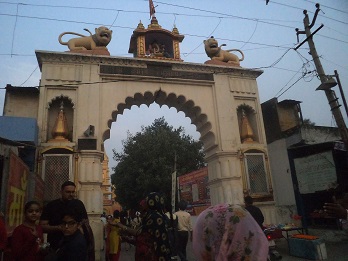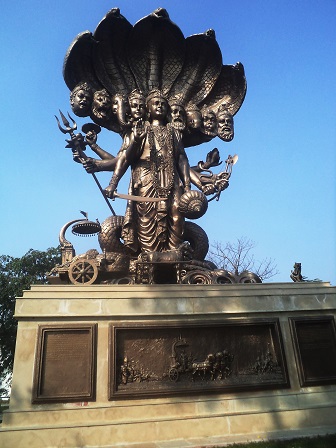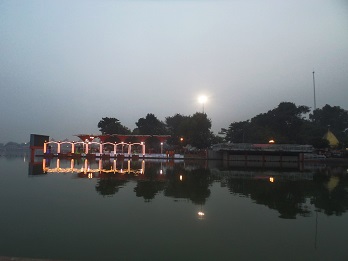The best way to discover India is to unravel the spirituality woven into the fabric of its age-old spiritual destinations. Kurukshetra serves as the best choice and offers a chance to go back to the epic age.
The pace of life picks up during the festive season and for those who have a penchant to discover the spiritual fabric of India, here’s a tranquil, pilgrim point of Kurukshetra in Haryana that makes you travel back in time. Renowned as the highly revered destination by the devouts, it was in Kurukshetra where sage Manu had penned down Manusmriti dating back to the 2nd Century BC and the rishis had compiled Rig Veda and Sama Veda at this destination. Besides, Kurukshetra has been regarded as the birthplace of Bhagavad Gita where Lord Krishna had delivered his philosophy of Karma to Arjuna before the battle of Mahabharata.




For the discerning travellers looking ahead to understand the genesis of the epic age and get lost in Indian mythology, there is no better spiritual point than Kurukshetra where time flows at a less hurried pace. After a plethora of apprehensions that are quite normal while planning a trip to a new destination, we embarked from New Delhi to Kurukshetra during post-Navratri days. We set out in the morning and it took a couple of hours to reach the outskirts of the National Capital Region (NCR). The drive from New Delhi to Kurukshetra through National Highway No. 44 is a smooth one and one has to pass through Murthal, a tiny hamlet in Sonipat district of Haryana for lunch break. Murthal is around 45 km from New Delhi and has a cluster of decent dhabas that rustle up mouth-watering Punjabi delights. Murthal is widely famed for its Parathas, has some of the best dhabas in the country, and forms a convenient stopover for travellers heading to any destination in Punjab. At Murthal, we alighted at Mannat dhaba and had a chance to take a delectable culinary journey of Punjabi thali comprising Parathas, Dal makhani, Masala gobhi, Raita, and Gulab jamun.
After lunch, we departed to proceed to Kurukshetra, a distance of 170 km from New Delhi. Once known as Thaneswar, the fabled city of Kurukshetra, named after King Kuru blends with Thaneswar and has an old-world feel. In the bygone days, Kurukshetra was on the banks of river Saraswati and witnessed the battle of Mahabharata. The destination stands as a mute reminder of the rise and fall of several powerful Indian dynasties.
We had put up at a hotel in the vicinity of Brahma Sarovar. There are a plethora of attractions in Kurukshetra and our exploration of the pilgrim destination began with Shri Devikoop Bhadrakali Shaktipeeth temple. Lying around 2½ km away from the town, the shrine on Jhansa Road in Thaneswar is a site of divine bliss and enjoys the distinction of being one of the 52 Shakti Peethas in the country. Mythology puts forth that Goddess Parvati’s right ankle fell here. The main entrance also known as Shakti Dwar has a marble lotus with the anklet of Goddess Parvati. The shrine is also known as Savitri Peeth, Adi Peeth, Devi Peeth, and Kalika Peeth. The idol of Mata Vaishno Devi embraces the entrance of the shrine.
The offerings are made in the form of statues of horses which form the USP of the shrine. The Pandavas along with Lord Krishna had offered prayers at the shrine before the battle of Mahabharata. In the aftermath of the war, the Pandavas once again offered prayers at the shrine and donated horses and the tradition is kept alive. The shrine boasts of glitzy interiors flaunting the pantheons of Lord Krishna along with Radha, Lord Krishna’s cosmic form, and Lord Rama along with Sita. The sanctum sanctorum honours Goddess Kali, one of the nine forms of Durga. The shrine provides a sound opportunity for those interested to capture the images through their lenses.


Our next exploration site was the huge, fascinating Brahma Sarovar, a holy water reservoir where Lord Brahma had performed his first Yagna. Brahma Sarovar has a rich mythology and spreads over an area of 3.5 km forming one of the holiest sites in the ancient town. Ranked as one of the largest man-made water tanks in Asia, King Kuru had taken up the first renovation work of the water tank. The incredible Brahma Sarovar temple standing on the waters of the lake is devoted to Lord Shiva and has three entrance doors. Each door has intricately carved floral designs. One has to take the arch bridge from the bank to reach the shrine. As dusk descends, the entire Brahma Sarovar gets illuminated and with the cool breeze blowing amidst the chanting of hymns, the ambiance fills up with spiritual bliss. We stood there for a long and deep look feeling a sense of contentment and then retired for the day.
The next day we travelled to Jyotisar, a tiny hamlet around 8 km from Kurukshetra that once formed the battleground of Mahabharata. Besides, it was at Jyotisar where Lord Krishna had first recited the Bhagavad Gita to Arjuna under a banyan tree that remains intact today. The site where Lord Krishna had revealed his cosmic form to Arjuna was identified by Shankaracharya in the 9th Century. Later a chariot was installed at the site displaying the Gita Updesha on a raised platform facing the east. One can get to view a colossal statue of Lord Krishna in his cosmic form adjacent to the site. The entrance of Jyotisar temple has tiny, old-world, dilapidated shrines under a banyan tree. Jyotisar transports us to the pre-Harappan era.
Before winding up, we had a glimpse of Sannihit Sarovar, another sacred water reservoir in the heart of the city. The pages of mythology reveal that this reservoir serves as the meeting point of seven Saraswati rivers. Visitors arrive here to perform the rituals of the departed soul. However, a clean-up mission needs to be launched at the reservoir.
If you’re itching to travel and intend to elevate your spiritual experience, Kurukshetra should be on your bucket list.
by Swaati Chaudhury
Also Read
Watch on Youtube
